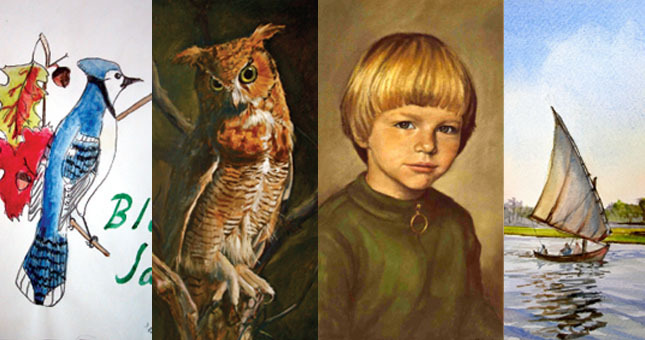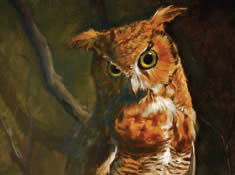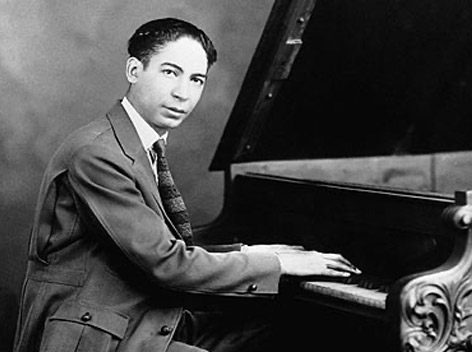
(From left to Right, Photos 1-4) Paintings by Phil Long
Looking Closely
How Being an Artist Helps Me as a Biblical Scholar
For as long as I can remember, I have enjoyed drawing (and, in due course, painting). Among the vignettes of earliest childhood that inhere in my memory, there is one of a drawing I did as a three or four-year old of a rather bulbous human body that piqued the curiosity (if not concern) of my parents: “Ah, that looks interesting; tell me about it….”
In my elementary school days, I took up watercolour and painted bird picture after bird picture [see photo 1, painted when I was nine]. My interest in the visual arts continued through high school and into my Wheaton College years where I majored in Art, because I loved it, and also in Biology, because it seemed more practical (translate: seemed to have a better chance of earning money). Beyond the pecuniary incentive, my interest in biology stemmed also from my love of nature and beauty. My interest in bird life continued, this time in oils [see photo 2]. After college, I married Polly and spent much of our first year of marriage earning a living by painting (or, rather, pastel-ing) portraits, mainly of children [see photo 3]. (For the record, biology has yet to earn me one red cent!) My love of painting has continued through the years, though other loves have meant that I often go long stretches without lifting a brush. Nowadays I am limited mostly to quick watercolours [see photo 4 of a felucca on the Nile].
What does this all have to do with the intersection of art and theology? Or, to be more specific to my theme, how has training and experience in the visual arts made me a better biblical scholar/theologian? The first thing that pops to mind is the way in which engagement in the visual arts trains one in “close observation.” One of the earliest lessons fledgling visual artists must learn—at least if they hope to render something of the world outside the confines of their own crania—is not to assume, for instance, what a tree looks like but, rather, to observe closely in order to discover what this particular tree looks like. Trunks are not simply grey or brown; leaves are not simply green, red, or yellow. Close observation discovers beautiful subtlety, and the artist’s task is to bring out the subtle variations in such a way that others can appreciate them as well. Nowadays, in my role as a biblical interpreter, close observation is similarly required. Readers of the Bible must never simply assume they know what a text is saying but, rather, are called to observe closely in order to discover what this particular text is saying.
A second thing that comes to mind is the way that engagement with visual, representational art (realist, impressionist, etc.) teaches artists the value of creative simplification in order to capture the “likeness” of their subjects. Often the most convincing paintings avoid what might be called the deadly morass of details and instead focus on capturing the general contours and tonalities of their subject while including just the few salient details that prompt the human mind to fill in the rest of the picture. Biblical narrators, I have discovered, craft their historiographies in much the same way—essential contours plus a few salient and suggestive details that enable the reader to “get the picture”: Esau is a hairy outdoorsman, Eli is dim-sighted, Saul is tall, David is small in stature but big in faith, Abigail is perspicacious as well as beautiful, and so on. Not a lot of detail, but just enough to tell us what we need to know.
A third observation: in the early 1980s, I was engaged in doctoral research at the University of Cambridge and learning many new and interesting things about the literary character of many biblical narratives that I had formerly regarded as chiefly historical texts. My new discoveries of the masterful literary devices in these texts—elaborate plots, sophisticated characterizations, verbal and dramatic irony, etc.—troubled me initially: “I always thought these texts were history, and now I’m discovering that they are literature!” One day it occurred to me that to think of biblical narratives as either history or literature is simply wrong-headed. It was my earlier professional activity as a portrait artist that triggered this thought. When I painted a portrait, I was most definitely engaged in a work of reference, a work of history, if you will. If my portrait did not capture the likeness of my historical subject, I didn’t get paid! But I was also engaging fully in a creative, artistic endeavour. Why then should biblical narratives not be both wonderfully crafted literary works and also works of history?
Not all visual art is, of course, meant to be representational. Some is meant to be primarily evocative or provocative. This helps me understand another aspect of the Bible’s rich textual character. As is well known, the Bible is a library of diverse literary genres and formal types: narratives, poems, prophecies, gospels, letters, apocalypses, and so forth. I have read that the Bible is about 40% poetry. Why? I believe that this is because the Bible’s Author wishes to address the whole person, intellect, will, emotions, joys, sorrows, and aspirations. Information is important, but so is evocation and transformation. In its varied and artistic literary forms, the Bible seeks to draw its willing readers into healing and salvific engagement of the whole person with God. The aesthetic is no less important in the pages of Scripture than in the art gallery or concert hall.
When asked several years ago to reflect on why I do art, I came to the conclusion that while some people do art because they have a creative urge that cannot be denied and others because they want to confront, or at least comment on, their world in some way, I do art largely out of a desire to connect and celebrate what I love—nature, people, family, colour, and contour. I paint to make tangible what I celebrate. This is one important way that I come to know. If theological study is aimed at coming to know God and his manifest grace to humanity, then the arts have a vital, even indispensible, role to play.





